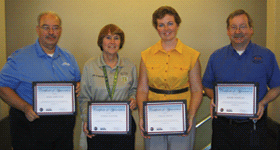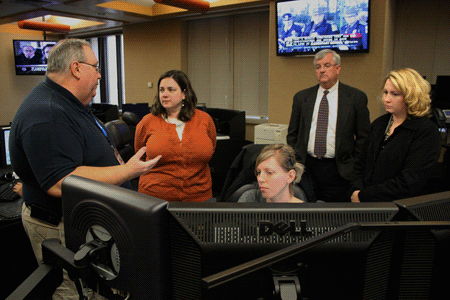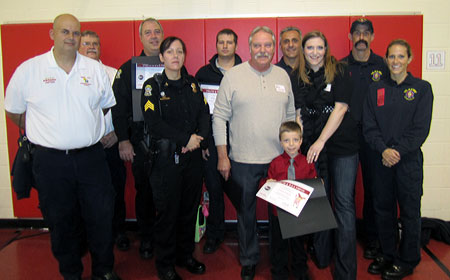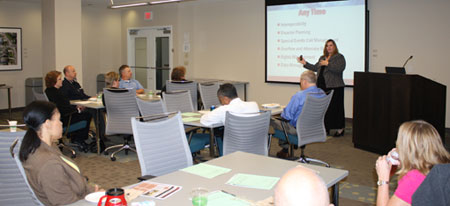
JANUARY 2013
MARC recognizes dispatchers and local government employees for cleaning up mapping database
MARC’s Regional Public Safety Communications program is honoring individuals who have gone above and beyond to help clean up the 9-1-1 database and mapping data.
This recognition is unique because the individuals being honored work across various departments — such as planning and zoning, community development and public safety.
To date, the following individuals have been recognized:
|
- Peggy Doss, Sugar Creek Police Department
- Debra Napier, Clay County Sheriff’s Office
- David Pavlich, City of Kearney
- Gail Porter, City of Blue Springs
- Kathy Robertson, City of Independence
- Mike Shelton, Riverside Public Safety
- Mark Whelan, Johnson County Emergency Communications
Gale Cantu and David Nelson from Platte County will be recognized in March.
Outstanding Performance Awards: Call for Nominations
MARC’s Regional Public Safety Communications program is now accepting nominations for the Outstanding Performance Awards (OPA), which will be presented on April 12, 2013, during the Telecommunicators Appreciation Celebration. The deadline to submit nominations is Feb. 4.
|
Award categories include:
- Outstanding Individual Performance in a Critical Incident
- Outstanding Team Performance in a Critical Incident
- Outstanding Supervisory Performance
- Everyday Hero
- Outstanding Training Performance
- Lifetime Achievement Award
A maximum of one award will be presented for each of the six award categories. The OPAs were developed to congratulate and acknowledge the exceptional work that telecommunicators do for first responders and for the public. Review the award criteria and submit a nomination form online or on the public safety intranet.
Elected officials learn about 9-1-1 at KCPD
|
On Friday, Dec. 14, Missouri state Sen. Jolie Justus and Rep. Judy Morgan met with MARC Public Safety Communications staff at the Kansas City, Mo., Police Department to learn about regional 9-1-1 operations and technological capabilities within metro public safety answering points.
Public Safety Program Director Keith Faddis and 9-1-1 Database Manager Saralyn Hayes were present to answer any questions regarding regional operations for 9-1-1 systems.
“Educating elected officials on how 9-1-1 systems work is just as important as educating the public on how to dial 9-1-1,” said Faddis. “Having the opportunity to demonstrate how 9-1-1 systems work and how we are improving our regional systems to elected officials is a valuable exercise. As representatives for the public, it is important for these officials to see that we are addressing emergencies while judiciously managing public funds.”
Hayes provided educational material for the elected officials, with data on call volumes and how MARC is addressing current and future FCC priorities.
New training requirements for Missouri telecommunicators
In August 2012, new rules and regulations were enacted regarding the 9-1-1 Training and Standards Act for the state of Missouri. The new laws and regulations impact credit hour requirements, curricula and qualifications for continuing education providers. The update in curricula requirements is more in line with current police officer standard training requirements. The new regulations are an update to original regulations enacted in 2000 and are intended to streamline the certification process for telecommunicators in Missouri.
The MARC Regional Public Safety Communications program is currently completing the application process to be an approved continuing education provider, but until the application is approved the state is permitting applicable courses taught at MARC for course credit.
New hires must complete the initial training within 12 months of their start date. Initial training requirements for new hires were not updated in the new rules and regulations and remain the same as the original training requirements enacted in 2000. To better understand how much training is required for new hires, the following chart categorizes hour requirements by the type of agency.
Agency |
Initial Training Requirements |
Law enforcement |
16 hours of police dispatcher training or 40 hours of joint communications dispatcher training |
Fire department |
16 hours of fire dispatcher training or 40 hours of joint communications dispatcher training |
EMS agency |
16 hours of emergency medical dispatch training or 40 hours of joint communications dispatcher training |
Joint communications center |
40 hours of joint communications dispatcher training |
The new rules and regulations require telecommunicators to complete a minimum of 24 hours of continuing telecommunicator education (CTE) every fixed three-year cycle with the first cycle ending Dec. 31, 2014. CTE credit may be obtained from the following sources*:
- CTE-approved provider
- Licensed continuing law enforcement education provider
- Missouri Department of Public Safety approved course
- Out-of-state course
- College-level courses related to communications, emergency management or applicable to communications or emergency management administration
- In service
- Serving as an instructor
The new regulations have also changed the old system of eight curricula areas into the following four areas:
- Legal
- Technical
- Interpersonal Perspectives
- Skill Development
For questions regarding the changes in regulations and courses offered by MARC, please contact Greg Hook at 816/701-8273 or ghook@marc.org.
*For complete guidelines regarding continuing education requirements, please reference the Missouri Codes and State Regulations, Title 11, Division 30, Chapter 13 regarding the 9-1-1 Training and Standards Act.
9-1-1 Hero: Gavin Haase
|
MARC’s Regional Public Safety Communications program and the Johnson County Sheriff’s office honored a Black Bob Elementary student, his neighbor and the dispatchers who helped him save his mother’s life at a 9-1-1 Hero Award ceremony on Oct. 22. The ceremony was held at Black Bob Elementary and was part of an all-school assembly focused on building character and being a responsible citizen.
On Sept. 12, Gavin Haase dialed 9-1-1 and ran to get help from his next-door neighbor, John Hards, after his mother had a seizure. Gavin’s mother, Katherine Haase, hit her head on the kitchen drawer and was rendered unconscious and bleeding.
On the other end of the line was Master Deputy Sam Soliday with the Johnson County Sheriff’s Office. Although Gavin had left the phone, Soliday heard frantic commotion and kept the line open.
After entering the home, Hards picked up the phone and informed dispatchers that Katherine had a seizure and confirmed the Haase’s address.
The deputy knew this was a medical emergency and sent the call to the Johnson County Emergency Communications Center where Dispatcher Ryan Reschke took over the call. Police and an ambulance were then sent to Gavin’s house.
Gavin is a hero for dialing 9-1-1 and seeking assistance from his neighbor. His quick thinking and the assistance he received from local dispatchers saved his mother’s life.
More information on the Kansas City Regional 9-1-1 Hero Award can be found on the public safety communications program website.
Public safety managers learn about migrating to NG9-1-1
|
On Thursday, Nov. 29, the Regional Public Safety Communications program at MARC hosted a session detailing how the North Central Texas Council of Governments (NCTCOG) and PSAPs within the Dallas/Ft. Worth region have started the transition to Next Generation (NG) 9-1-1. Christy Williams, program manager for the NCTCOG regional 9-1-1 system, led the discussion.
This session offered a comparison of the internal fears PSAPs may have about making the transition to NG9-1-1 and current expectations of the general public. Some of the concerns raised by attendees included costs, training and understanding texting terminology.
While PSAPs face legitimate concerns about making this transition, citizens believe that many of these services are already in place. NCTCOG conducted a survey with regional participants between ages 18 and 49. The data showed that 31 percent of these individuals believed that they could already text emergency notifications to 9-1-1.
Williams offered words of encouragement for PSAPs making this transition. “We have done it all before, folks.” She emphasized that telecommunicators who have been in the field for multiple decades have seen PSAPs transition to the use of VoIP, new computer technologies and GIS technology for location identification.
The presentation stressed that this will not be an instant change and success will require collaborating with and educating policy makers, citizens, vendors and first responders.
In addition to her current position at NCTCOG, Williams currently serves as the 2nd Vice President for the National Emergency Number Association and has more than 20 years of
9-1-1 industry experience.
Upcoming Training Opportunities
Feb 5: 9-1-1 Customer Service
Feb. 7: TTY Training
Feb. 11-15: Basic Telecommunicator Training
Feb. 19–20: Basic Fire Communications
Feb. 26: Refresher for the Experienced Telecommunicator A (RET A)
Feb. 28: 9-1-1 Equipment Training
March 5: 9-1-1 Crisis Calls
March 7: Mo-TERT Basic Awareness for Deployment
March 11–14: Communications Unit Leader (COML)
See a complete list of upcoming
9-1-1 training opportunities and GTI courses included in the
9-1-1 training consortium membership.
Special Events and Trainings
Feb. 21: PDS — Generational Differences
Maintenance Services
In nonemergency situations, you may email maintenance requests or questions to 911techs@marc.org.
If your issue requires immediate attention, or if you think it might, please call 816/421-2911 any time day or night.
![]() Remember, it is important to reboot your 9-1-1 workstations at least once each week, Monday through Friday between 8 a.m. and 5 p.m., when a MARC communications technician is available should you experience any problems. This will automatically update the GeoLynx map data on your workstation.
Remember, it is important to reboot your 9-1-1 workstations at least once each week, Monday through Friday between 8 a.m. and 5 p.m., when a MARC communications technician is available should you experience any problems. This will automatically update the GeoLynx map data on your workstation.
PSAP Managers Forum
The PSAP Managers Forum is an excellent resource for managers and supervisors to share and exchange ideas, concerns and suggestions.
Have a story you want to share?
Email Paul Lampe or call 816/701-8366.
600 Broadway, Suite 200 | Kansas City, MO 64105
ph: 816/474-4240 | fax: 816/421-7758
www.marc.org/publicsafety | e911@marc.org




 Christy Williams presents ways to effectively transition to Next Generation 9-1-1
at the November Professional Development Series program.
Christy Williams presents ways to effectively transition to Next Generation 9-1-1
at the November Professional Development Series program.